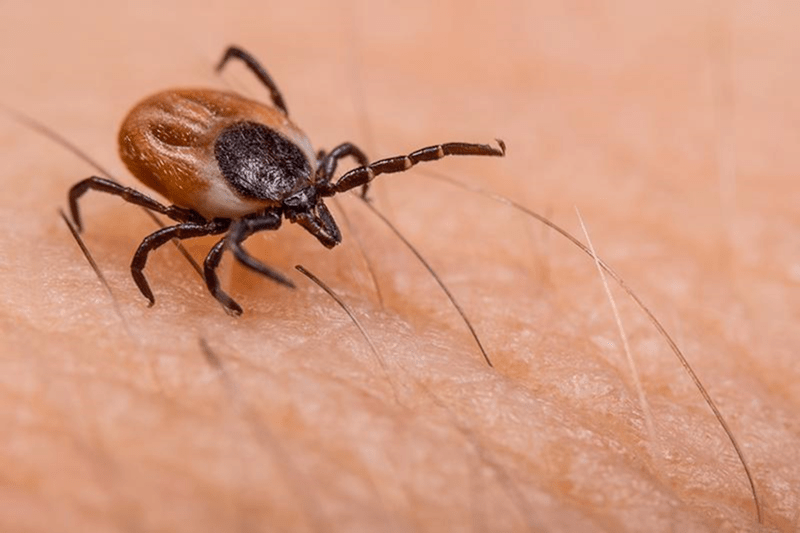According to the Centers for Disease Control and Prevention, approximately 30,000 cases of tick-borne diseases including Lyme disease and Rocky Mountain spotted fever are reported every year. Ticks can be dangerous to humans and pets alike—and they are so small, you might not even notice them right away. Here's what you need to know about ticks and how to avoid them.

Types of ticks
Ticks are a type of external parasite that feed on the blood of mammals. There are two major tick families: soft-shell ticks and hard-shell ticks. Soft-shell ticks feed in short periods, typically less than an hour and hard-shell ticks can feed continuously for up to a week. Ticks are attracted to hosts by their breath, body odor, body heat, moisture, and vibrations.
Ticks can't fly and they don't jump onto hosts. Instead, they “quest", which involves planting their back two pairs of legs on a surface (like a blade of grass) and raising their first pair of legs in the air. When the host brushes by them, they'll gently climb aboard, without the host noticing.
There are many species of ticks in North America, but here are some of the most common ones and what you should know about them:
American dog tick
Appearance: Dark reddish-brown with faint silvery markings and about a quarter of an inch long.
Behavior: Often referred to as a wood tick because they live in wooded areas populated by mammals, American dog ticks require blood meals in order to grow and lay eggs.
Habitat: Mostly found in states East of the Rocky Mountains and some parts of Western states like California, Idaho, and Washington. They live outdoors in wooded areas and fields in secluded or rural settings.
Black legged tick
Appearance: Dark brown to black body with darker legs. Adults are an eighth of an inch and young nymphs may be as small as a pinhead.
Behavior: As the primary vector of Lyme disease in the U.S., black legged ticks are also known as deer ticks for their tendency to go after deer and larger mammals, including humans. They usually attach themselves in inconspicuous areas of the body like on the back or under the hairline.
Habitat: Primarily found in the Eastern U.S., especially Northeast. They live in wooded, shady, outdoor areas where potential hosts like deer and rodents roam.
Brown dog tick
Appearance: Dark reddish-brown with no markings, a brown dog tick is about a quarter of an inch with females reaching half an inch after a blood meal.
Behavior: Capable of surviving up to eight months without feeding, brown dog ticks are unique in that they are the only tick that can complete their full life cycle indoors.
Habitat: Brown dog ticks are found throughout the U.S. in heavy vegetation and tall grasses and in yards around shrubs, dog houses or kennels. They can infest homes after being carried indoors by a pet and laying eggs.
Lone star tick
Appearance: About a quarter of an inch long and grayish brown with a white dot in the center top of the abdomen that resembles a star.
Behavior: Lone star ticks are more aggressive than other types of ticks and will actively seek out a host rather than waiting for one to come to them.
Habitat: Found throughout the Eastern and Southeastern of the U.S. in outdoor, wooded areas and fields.
Soft tick
Appearance: Vary from sandy brown to reddish or dark brown and about a quarter of an inch long. They have an oval body shape with mouthparts hidden underneath the body.
Behavior: Common fowl ticks and relapsing fever ticks are both soft-shell ticks that are attracted to rodents and birds as their hosts. They are found in cabins, rural homes and secluded buildings that are infested with the pests they use as hosts. They may attach themselves to human hosts in certain circumstances.
Habitat: An area or building with a rodent infestation is the perfect habitat for a soft tick. They are attracted to rodent burrows, attics, wall voids, and crawl spaces where mice and rats often live.
Want to avoid a tick infestation? Learn more about our tick control services.
Tick prevention tips
Preventing a tick infestation all depends on how you maintain the grounds and landscaping on your property. Since ticks usually live in wooded, grassy areas, make sure to keep any vegetation near your business tidy and trimmed. If you want to be sure your business is protected against ticks, pest control professionals can help by inspecting your property and creating a customized treatment plan you can count on long-term.
Ready for us to step in? Call us at 877.837.6464 to schedule a free, no-obligation assessment.



